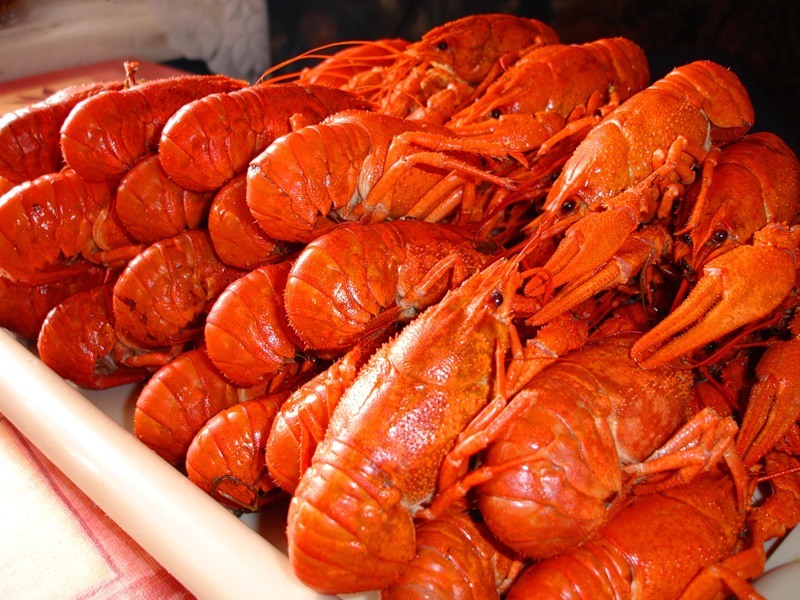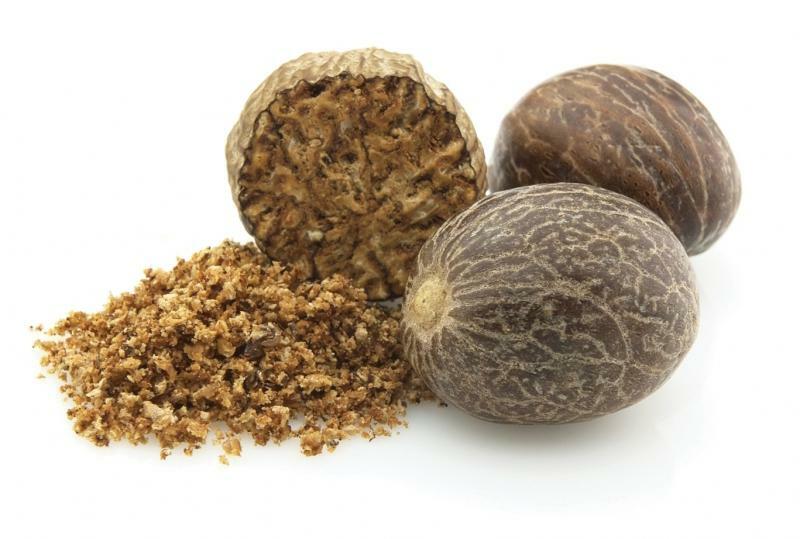Diet when removing the gallbladder by laparoscopy
home » Other » Nutrition » Diet when removing the gallbladder by laparoscopy
Surgery to remove the gallbladder is called cholecystectomy. This procedure is indicated for patients with severe cholecystitis, obstruction of the biliary tract with calculi, gangrene of the gallbladder. Today, the most gentle form of surgical intervention is laparoscopy.
Although this manipulation has a minimal risk of complications and is quite easily tolerated by patients, a number of rehabilitation measures are necessary after the operation. The most important restorative measure is adherence to a special diet.

Diet when removing the gallbladder by laparoscopy
Content
- 1 Features of the operation
- 2 Features of dietary nutrition after laparoscopy
-
3 Postoperative diet
- 3.1 Features of nutrition in the first week after laparoscopic cholecystectomy
- 4 Nutrition 7 days after surgery
- 5 Permitted products
- 6 Foods that are not recommended for food
-
7 Healthy recipes
- 7.1 Video - Diet after removal of the gallbladder
Features of the operation
Laparoscopic cholecystectomy is an operation that involves excision of the gallbladder using a rigid endoscope - a laparoscope. The main difference between this procedure and classical surgical intervention is that the specialist gains access to the affected area through a small puncture. In this case, there is no need to make a cavity incision, which makes the manipulation much less traumatic.
Attention! Excision - literally "cutting" or "excision". It involves the complete removal of an organ or part of the body.

Difference between laparoscopic and open cholecystectomy
Several punctures are made in the patient's anterior abdominal wall through which instruments are inserted into the patient's body. The camera on the endoscope broadcasts the entire process of the surgical intervention on the monitor screen. The doctor fills the patient's abdominal cavity with carbon dioxide, then separates the gallbladder from the liver and installs drains - special tubes required to drain the secreted after surgery liquids.
The procedure takes about 45-55 minutes and is performed under general anesthesia. Normally, such manipulation has a minimal negative impact on the functioning of various systems of the patient's body.
Cholecystectomy is performed in patients diagnosed with dysfunction of the gallbladder or ducts that does not respond to pharmacological treatment. Such diseases include the following disorders:
- cholelithiasis - the formation of stones in the gallbladder and ducts;

Gallstones
- inflammatory processes in the gallbladder caused by infection;
- acute cholecystitis, recurrence of chronic cholecystitis;
- polyposis changes - the proliferation of multiple benign neoplasms.
After the operation, the patient is in a medical clinic for 2-5 days, where his condition is monitored by specialists. On the first day, the patient must observe strict bed rest, eating food on this day is prohibited. With strong thirst, it is allowed to drink warm water in small sips of no more than 500 ml.
In 24-36 hours after the surgical intervention, the patient is allowed to move independently around the ward, to eat. The diet during this period is limited to a few tablespoons of dietary broth or jelly. Gradually, the menu begins to include various dishes with a minimum amount of fat. Any changes in diet should only take place after consulting a doctor.

Scheme of laparoscopic surgery
36-48 hours after the operation, a drainage tube is removed from the patient's abdominal cavity. From this point on, the patient must follow a diet for the normal restoration of digestion and take appropriate treatment. An obligatory element of therapy is the use of ursodeoxycholic acid, which serves as a substitute for bile secretion.
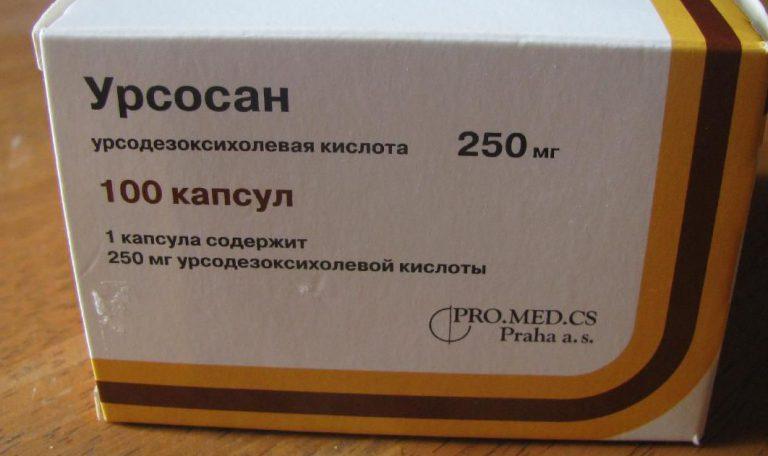
Ursosan drug
Attention! A restorative diet should be followed for four weeks after surgery. Also during this period it is forbidden to engage in physical labor, visit swimming pools and saunas, and experience strong emotional stress.
About 30 days after the excision of the gallbladder, the patient can return to their normal lifestyle. However, adherence to diet remains an integral part of therapy.
Features of dietary nutrition after laparoscopy
After the operation to remove the gallbladder, the patient must follow a therapeutic diet - table No. 5 according to Pevzner. This is a special diet aimed at ensuring the normal function of the liver, gastrointestinal tract and biliary tract. While adhering to the dietary menu, the patient consumes a normal amount of carbohydrates and proteins and a significantly lower percentage of lipids.
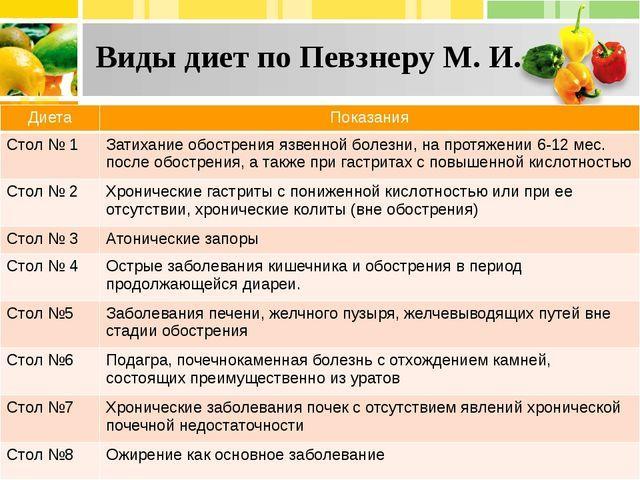
Types of diets according to Pevzner
After cholecystectomy, the patient must adhere to the principles of mechanical and thermal sparing when preparing meals. Food should be boiled, steamed or baked without adding fat or oil. Also, while dieting, you need to compose your diet based on the following rules:
- The amount of daily calorie intake should be determined by a gastroenterologist or nutritionist, based on the individual characteristics of the patient's health, his age and body weight.
- The amount of salt, spices and flavorings in dishes should be kept to a minimum. Do not use hot spices during cooking, as well as butter or lard for frying meat or fish.
- Meals should be fractional: you should eat at least five times a day. For lunch and afternoon tea, it is recommended to choose light meals rich in fiber and vitamins - fruits, vegetables, salads, etc. Such a diet contributes to the regulation of digestive processes and facilitates the digestion of chyme and its movement along intestines.
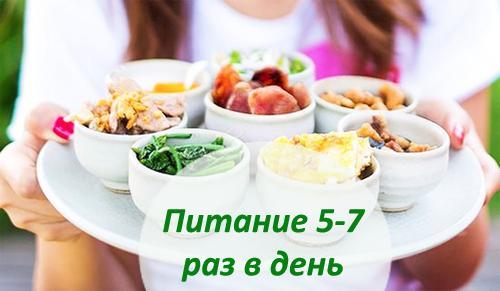
Meals should be fractional and at least 5 times a day
- To avoid stagnation of bile, in the morning before breakfast, you should drink a glass of water at room temperature.
- The most high-calorie meals should be consumed at lunchtime. The calorie content of the dinner should be no more than 25% of the total.
- The temperature of food when serving should be no more than 38 ° C. Excessively hot dishes cause an active release of bile, and too cold can lead to spasm of the sphincter of Oddi.
Attention! The sphincter of Oddi is a smooth annular muscle that controls the flow of bile into the duodenum. Spasm of the sphincter can cause severe abdominal pain, vomiting, and impaired peristalsis.

Sphincter of Oddi
Postoperative diet
The main feature of nutrition after laparoscopic cholecystectomy is that the period of severe hunger is significantly reduced. If the patient is in good health, then the first full meal is allowed one day after the procedure.
Features of nutrition in the first week after laparoscopic cholecystectomy
| Time period after surgery | Recommended menu |
Image |
|---|---|---|
| The first 5-6 hours after the intervention | Dry hunger must be observed. It is forbidden to take food and any drinks |
 |
| Period 6-24 hours after the procedure | Within a few hours, the patient needs to drink 0.5 liters of still water at room temperature. At one time, you should take no more than two sips, followed by a break for 10-15 minutes. |
 |
| The second day after cholecystectomy | The menu on this day may include low-fat kefir, creamy vegetable soup, liquid oatmeal in water, jelly without added sugar. Food should be taken every three hours, serving size should not exceed 0.5 cups |
 |
| 3-4 days after surgery | During this period, the patient is allowed light meals that are easy to digest and contain a minimum of fat. The menu includes fermented milk products, liquid or ground cereals, various types of jelly and jelly, slime soups, fish fillets and lean meat. The diet might look like this: · Before breakfast: half a glass of boiled water at room temperature; Breakfast: 4-5 tablespoons of liquid oatmeal with the addition of ¼ grated apple, protein omelet, rosehip drink; · Lunch: natural low-fat yogurt, unsweetened jelly; · Chicken broth with egg white, beef soufflé, chamomile broth; Afternoon snack: plum jelly, cottage cheese casserole, water with lemon; · Dinner: vegetable puree and 150 g of fish fillets, tea; At night: half a glass of 1% kefir |
 |
| 5-8 days after cholecystectomy | At the end of the first week after surgery, the patient's diet should be aimed at normalizing the functioning of the gastrointestinal tract, improving digestion and peristalsis. With this diet, the patient should eat six times during the day. To reduce the load on the gastrointestinal tract, the serving size should not exceed 200-250 g. Sample menu for the day: · Before breakfast: a glass of boiled water with a teaspoon of honey; Breakfast: grated buckwheat porridge, the protein of one egg, tea with lemon; · Lunch: baked apple without skin, jelly; · Lunch: broccoli soup with chicken, fish balls with mashed potatoes, unsweetened compote; · Afternoon snack: cottage cheese casserole, fruit mousse; · Dinner: steamed beef cutlets, steamed grated vegetables, sea buckthorn drink; At night: a small pear, half a glass of low-fat milk |
 |
Attention! Diet in the first week after cholecystectomy is necessary to normalize the work of all body systems. It is the key to a successful course of the treatment and recovery period. Dishes that are introduced into the diet should be selected taking into account the individual characteristics of the patient's health.
Nutrition 7 days after surgery
The diet for patients with cholecystectomy is based on the following principles:
- It is necessary to eat often, but in small portions. The optimal interval between meals is no more than 2.5-3 hours.
- Before going to bed, you should drink a glass of low-fat milk or kefir. These foods will eliminate the feeling of hunger, but will not cause a feeling of heaviness in the stomach.
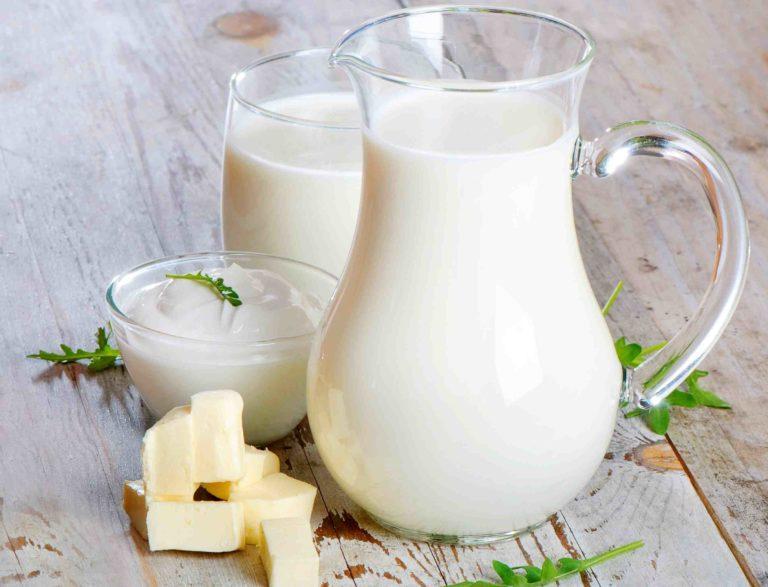
Before going to bed, you should drink a glass of low-fat milk or kefir.
- The diet should be dominated by foods rich in vitamins.
- You should stop drinking alcoholic beverages. Even a small amount of alcohol can be detrimental to the patient's condition.
- The volume of fluid that the patient consumes during the day should be at least two liters.
- The basis of the menu should be soups and mucus-forming products. Foods rich in lipids and fast carbohydrates in the patient's diet should be minimized.
- Peel the fruit before eating.

Fruit should be eaten without the skin
It is recommended to adhere to these general principles of nutrition for patients with cholecystectomy throughout their lives. Such a diet will serve as the prevention of diseases of the gastrointestinal tract and liver in the future.
Permitted products
The list of foods that people can eat after cholecystectomy is quite extensive. However, patients should consult a physician in order to formulate a diet that will provide the body with all the necessary substances.
-
Bread and pastries. Dried rye or wheat bread, biscuits, flat cakes from unleavened dough are allowed. In a small amount 1-2 times a week, you can use pies made of non-tasty dough with fish fillets, apple jam, low-fat cottage cheese.
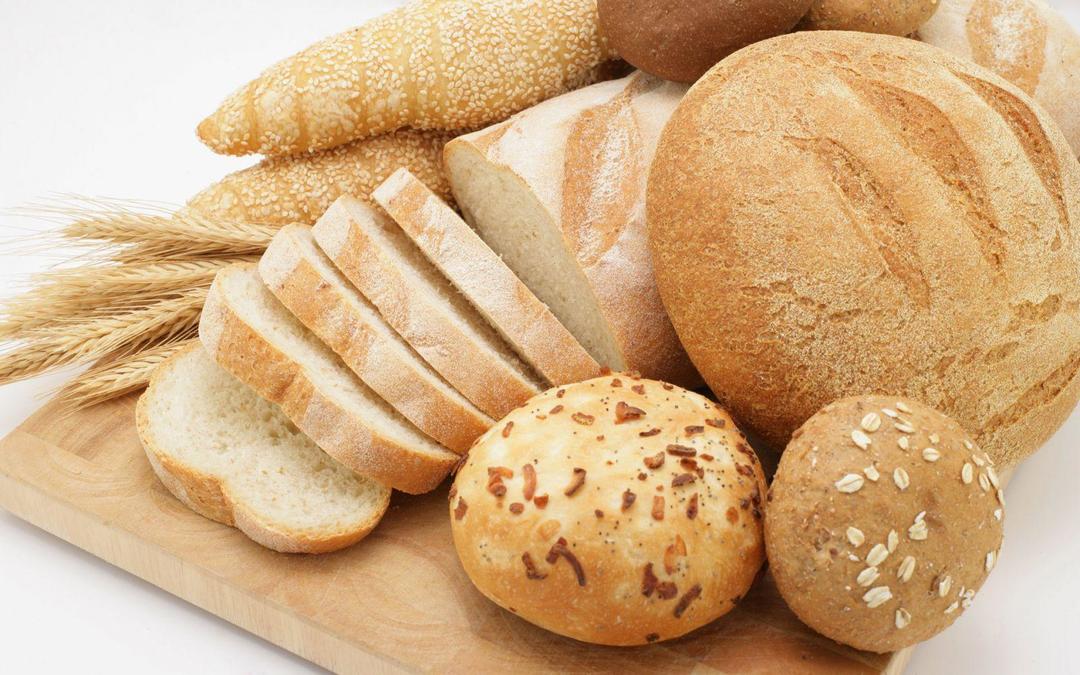
Bread is allowed to be consumed yesterday and dried
- Soups. Mashed soups are especially useful. They are easily digested and easily absorbed without overloading the gastrointestinal tract. Preference should be given to slime cereal and vegetable soups, broths on lean meat, cream soups with milk.
- A fish. The greatest benefit to the body is provided by the fillet of low-fat fish. It can be boiled, baked with vegetables, soufflé or steamed cutlets. This product allows you to get a lot of amino acids that increase the overall tone of the body.
- Milk and its derivatives. All milk products for patients after gastric excision should be low in lipids. You can cook healthy and tasty dishes from kefir, cottage cheese and sour cream: cheese cakes, casseroles, dumplings, sauces, mousses. In a small amount, it is allowed to use low-fat cheese without spices.
-
Meat. After surgery, patients can eat poultry or lean beef. In this case, the dishes should be steamed or baked in the oven without adding oil and lard.

After the operation, it is allowed to eat poultry
- Oils. The amount of lipids in the diet of patients should be minimized. It is recommended to consume no more than 20 g of unsalted butter per day. Dishes can be seasoned with olive oil, refined vegetable oil or oatmeal oil.
- Cereals. The most beneficial for the body are oatmeal, pearl barley and buckwheat porridge. You can cook them with milk and a little sugar, or with vegetables and a little meat. Also, baked goods, casseroles, puddings are made from cereals.
- Eggs. Chicken, goose and quail eggs can be eaten 2-3 times a week in the form of steamed omelets or additions to the main course.
- Vegetables. They are used as independent dishes or as side dishes. The most useful are carrots, broccoli, cauliflower, boiled green peas, potatoes, cucumbers, pumpkin. You can also cook caviar, salads, stews, etc. from vegetables.
-
Fruits. It is recommended to consume non-acidic fruits and berries. Peaches, large grapes, apricots and apples should be peeled beforehand. You can also make jams and jams, natural marmalade, compotes and jelly, mousses from fruits.

It is recommended to consume non-acidic fruits and berries
- Sweets. Preference should be given to sweets with a minimum of chocolate and lipids. These are marshmallows, marshmallows, caramel, dried biscuit, fruit ice in small quantities.
- Beverages. The most useful are non-acidic juices and fruit drinks, herbal teas, natural teas with lemon or pieces of berries and fruits.
-
Food additives. It is recommended to prepare various sauces and dressings on your own from sour cream, milk, vegetables and fruits. As a seasoning for food, you can use cilantro, parsley, dill, lemon balm, basil.

It is recommended to prepare various sauces and dressings on your own.
Attention! After removal of the gallbladder, its function - the accumulation and release of bile - is taken over by the liver. Therefore, the patient must follow a gentle diet throughout his life.
Foods that are not recommended for food
Some foods after cholecystectomy should be excluded from the diet so as not to provoke indigestion or hepatic colic:
- Fried rolls, pies, pastries and buttercream cakes. It is not recommended to use pastries or puff pastries.
- Mushrooms, especially fried or pickled. This product takes a long time to digest and is poorly absorbed by the body.

It is not recommended to eat fried or pickled mushrooms
- Fatty soups containing a lot of meat, cream, seasonings, or fermenting vegetables.
- Canned food, sausages, smoked meats and salted meat or fish. Care should be taken with dishes containing pork and fatty fish.
- Fatty sour cream, milk, cream and cottage cheese also have a detrimental effect on the liver.
- Lard, bacon, bacon.
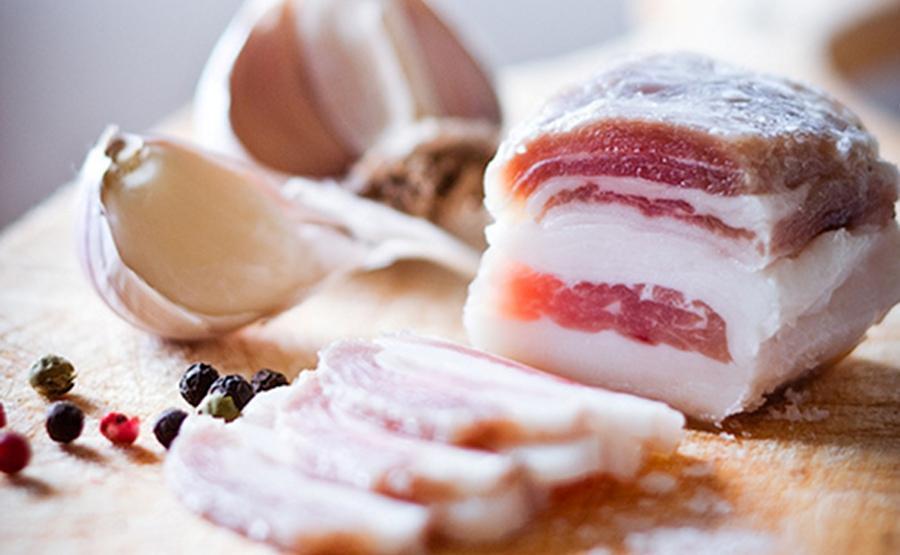
Lard, bacon, bacon are prohibited after laparoscopy
- Beans should be eaten with caution.
- Any spicy and fatty snacks are contraindicated for use.
- Sweets: fatty ice cream with animal protein, chocolate and chocolate products, popcorn, etc.
- Carbonated drinks, strong coffee, milkshakes, alcohol.
- Mustard, ketchup, mayonnaise, any sauces with a lot of spices.

Table number 5 according to Pevzner
Healthy recipes
Some dishes are not only tasty, but also have a beneficial effect on the patient's body after cholecystectomy. The following recipes can be included in the patient menu:
- Chicken with Egg Snack: Boil one chicken breast, then place it in a blender with one egg white, finely chopped apple, tomato and onion. Grind. The resulting mixture can be spread on toasted bread or used as an additive to a side dish.
- Rice hedgehogs: Mix 500 g of ground beef with a cup of boiled rice and chopped onion. Roll into balls from the resulting mixture. Bake in the oven until tender.
- Chicken puree soup: boil chicken with vegetables. Drain 2/3 of the liquid, grind the remaining mixture in a blender, add ½ cup of milk, beat with a whisk. Can be served with croutons and herbs.
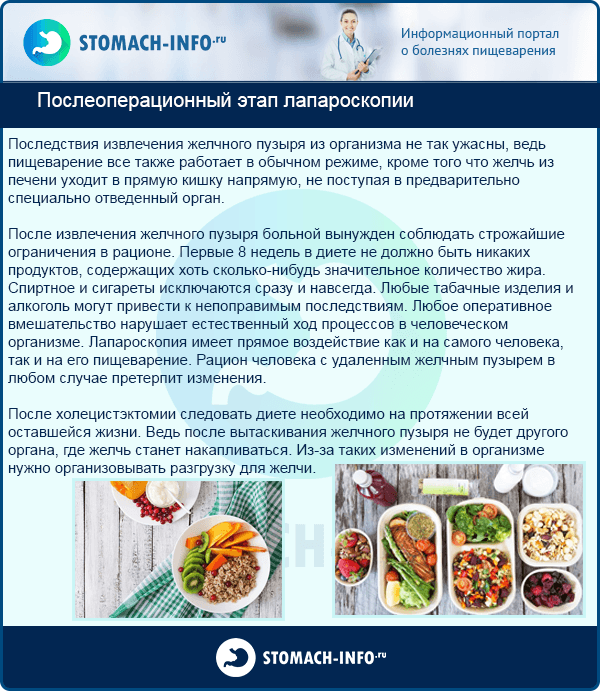
Postoperative laparoscopy
Laparoscopic cholecystectomy is an operation to remove the gallbladder. After this procedure, the patient must follow a diet throughout his life. The patient's diet should include meals with a low lipid content. In this case, food should be complete, rich in nutrients. A gastroenterologist or nutritionist chooses a diet that takes into account the individual characteristics of the patient's health.


